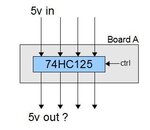henninggs
Member level 2

Hi.
I'm new to all this and learning every day.
This might be a very basic question and I do think I have understand it the correct way, just need to be sure.
I have a quad bus buffer, the 74HC125. In the data sheet it says:
This means that if there is no signal going to the !OE pin the device is enabled, right ?
But does "active low" also mean that the device is enabled EVEN if there is no current on the Vcc pin ?
Is the 74HC125 "enabled" when I hold it in my hand not connected to anything - or will the state be "undefined" if no power is supplied?
I'm new to all this and learning every day.
This might be a very basic question and I do think I have understand it the correct way, just need to be sure.
I have a quad bus buffer, the 74HC125. In the data sheet it says:
The “125” is identical to the “126” but has active LOW enable input
This means that if there is no signal going to the !OE pin the device is enabled, right ?
But does "active low" also mean that the device is enabled EVEN if there is no current on the Vcc pin ?
Is the 74HC125 "enabled" when I hold it in my hand not connected to anything - or will the state be "undefined" if no power is supplied?


